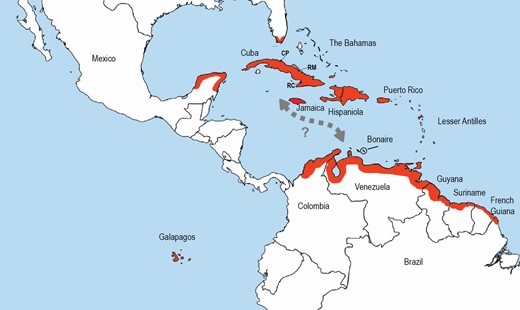Jim LeNomenclatoriste
Je suis un mignon petit Traquet rubicole

Frias-Soler & al. 2022. Phylogeny of the order Phoenicopteriformes and population genetics of the Caribbean flamingo (Phoenicopterus ruber: Aves)

 academic.oup.com
Abstract
academic.oup.com
Abstract
Flamingos are highly mobile waterbirds that can be found in tropical and subtropical regions worldwide. The large distribution range of flamingos, the inaccessibility of most of their breeding sites and the lack of species-specific molecular markers, such as microsatellites, have hampered population genetics studies of these majestic birds. Here, we developed a library of microsatellite loci primers using high-throughput sequencing technology that could be used for further genetic studies on Phoenicopteriformes. Microsatellite and mitochondrial markers were employed for the genetic characterization of individuals of all flamingo species and their hybrids, and to conduct a population genetics study of the Caribbean flamingo. The phylogeny of Phoenicopteriformes was confirmed with six species grouped in two major clades that diverged approximately 13 Mya. This suggests the existence of two genera of flamingos, not three, as is currently accepted. The analysis of the genetic structure of the Caribbean flamingo shows that all Cuban demes constitute a single population isolated from the Bonairean colony. This supports suggestions of the existence of limited connectivity between northern and southern Caribbean colonies. The small Galápagos colony was confirmed as an isolated population with low genetic diversity; thus, it should be considered as threatened.

Phylogeny of the order Phoenicopteriformes and population genetics of the Caribbean flamingo (Phoenicopterus ruber: Aves)
Abstract. Flamingos are highly mobile waterbirds that can be found in tropical and subtropical regions worldwide. The large distribution range of flamingos, the
Flamingos are highly mobile waterbirds that can be found in tropical and subtropical regions worldwide. The large distribution range of flamingos, the inaccessibility of most of their breeding sites and the lack of species-specific molecular markers, such as microsatellites, have hampered population genetics studies of these majestic birds. Here, we developed a library of microsatellite loci primers using high-throughput sequencing technology that could be used for further genetic studies on Phoenicopteriformes. Microsatellite and mitochondrial markers were employed for the genetic characterization of individuals of all flamingo species and their hybrids, and to conduct a population genetics study of the Caribbean flamingo. The phylogeny of Phoenicopteriformes was confirmed with six species grouped in two major clades that diverged approximately 13 Mya. This suggests the existence of two genera of flamingos, not three, as is currently accepted. The analysis of the genetic structure of the Caribbean flamingo shows that all Cuban demes constitute a single population isolated from the Bonairean colony. This supports suggestions of the existence of limited connectivity between northern and southern Caribbean colonies. The small Galápagos colony was confirmed as an isolated population with low genetic diversity; thus, it should be considered as threatened.




